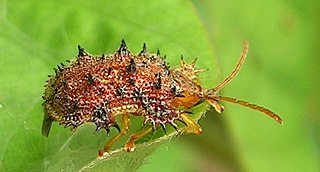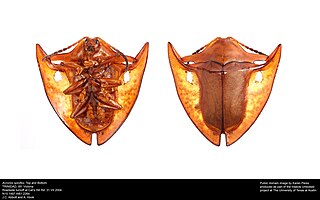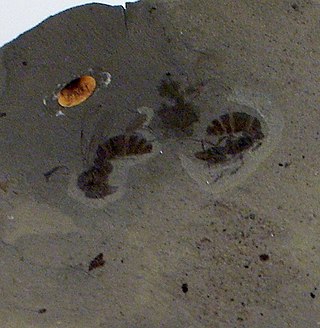
The Cassidinae are a subfamily of the leaf beetles, or Chrysomelidae. The antennae arise close to each other and some members have the pronotal and elytral edges extended to the side and covering the legs so as to give them the common name of tortoise beetles. Some members, such as in the tribe Hispini, are notable for the spiny outgrowths to the pronotum and elytra.
Fibla carpenteri is an extinct species of snakefly in the Inocelliidae genus Fibla. F. carpenteri is named in honor of the paleoentomologist Dr Frank Carpenter, for his vast knowledge and interest in Raphidioptera.

Styporaphidia is a genus of snakefly, belonging to the extinct family Mesoraphidiidae, containing up to three species, the type species Styporaphidia magia, Styporaphidia willmanni and tentatively Styporaphidia? hispanica. The genus was named from the Greek stypos meaning "stem" or "stump" and Raphidia, the type genus for, and most often used as, a stem for generic names in the order Raphidioptera. The species name of S. magia is from the Greek word mageia meaning "magic" while the species name for S.? hispanica is from the Latin Hispania meaning "Spain" in reference to the type locality of the species.

Archiinocellia is an extinct genus of snakefly in the family Raphidiidae known from Eocene fossils found in western North America. The genus contains two species, the older Archiinocellia oligoneura and the younger Archiinocellia protomaculata. The type species is of Ypresian age and from the Horsefly Shales of British Columbia, while the younger species from the Lutetian Green River Formation in Colorado. Archiinocellia protomaculata was first described as Agulla protomaculata, and later moved to Archiinocellia.

Prodryas persephone is an extinct species of brush-footed butterfly, known from a single specimen from the Chadronian-aged Florissant Shale Lagerstätte of Late Eocene Colorado. P. persephone is the first fossil butterfly to be found in North America, and is exquisitely well preserved. Its closest extant relatives are the mapwings and African admirals of the genera Hypanartia and Antanartia, respectively.

Acromis spinifex is a species of tortoise beetle from South America. The males have enlarged elytra which are probably used in male–male combat, while females are among the few tortoise beetles to show maternal care of their offspring.

Ypresiomyrma is an extinct genus of ants in the subfamily Myrmeciinae that was described in 2006. There are four species described; one species is from the Isle of Fur in Denmark, two are from the McAbee Fossil Beds in British Columbia, Canada, and the fourth from the Bol’shaya Svetlovodnaya fossil site in Russia. The queens of this genus are large, the mandibles are elongated and the eyes are well developed; a stinger is also present. The behaviour of these ants would have been similar to that of extant Myrmeciinae ants, such as solitary foraging for arthropod prey and never leaving pheromone trails. The alates were poor flyers due to their size, and birds and animals most likely preyed on these ants. Ypresiomyrma is not assigned to any tribe, and is instead generally regarded as incertae sedis within Myrmeciinae. However, some authors believe Ypresiomyrma should be assigned as incertae sedis within Formicidae.

Eosacantha is an extinct genus of tortoise beetle in the family Chrysomelidae and containing a single species Eosacantha delocranioides. The species is known only from the Middle Eocene Parachute Member, part of the Green River Formation, in the Piceance Creek Basin, Garfield County, northwestern Colorado, USA.
Emiliana is an extinct genus of planthopper in the Tropiduchidae tribe Emilianini and containing the single species Emiliana alexandri. The species is known only from the Middle Eocene Parachute Member, part of the Green River Formation, in the Piceance Creek Basin, Garfield County, northwestern Colorado, USA.
Uintascorpio is an extinct genus of scorpion in the family Buthidae and containing the single species Uintascorpio halandrasorum. The species is known only from the Middle Eocene Parachute Member, part of the Green River Formation, in the Piceance Creek Basin, Garfield County, northwestern Colorado, USA.

Diochus electrus is an extinct species of rove beetle in genus Diochus, the only definitive fossil species in subfamily Staphylininae. The species is known only from the middle Eocene, Lutetian stage Baltic amber found in the Blaue Erde deposits, Baltic region, Northern Europe.

Arostropsis is an extinct genus of broad-nosed weevil in the beetle family Curculionidae known from an Upper Eocene fossil found in Europe. The genus contains a single described species, Arostropsis groehni.
Protostephanus is an extinct genus of crown wasp in the Hymenoptera family Stephanidae known from an Eocene fossil found in the United States of America. The genus contains a single described species, Protostephanus ashmeadi placed in the stephanid subfamily Stephaninae.
Zophotermes is an extinct genus of termite in the Isoptera family Rhinotermitidae known from two Eocene fossils found in India. The genus contains a single described species, Zophotermes ashoki placed in the subfamily Prorhinotermitinae.
Aphaenogaster donisthorpei is an extinct species of ant in formicid subfamily Myrmicinae known from a Late Eocene fossil from North America. A. donisthorpei was one of two Aphaenogaster species described in the 1930 paper.

Aphaenogaster mayri is an extinct species of ant in formicid subfamily Myrmicinae known from a series of Late Eocene fossils found in North America. A. mayri was one of two Aphaenogaster species described in a 1930 paper by Frank M. Carpenter.
Eoprephasma is an extinct genus of stick insect in the susumaniid subfamily Susumaniinae known from a group of Eocene fossils found in North America. When first described there was a single named species, Eoprephasma hichensi.
This list of fossil arthropods described in 2009 is a list of new taxa of trilobites, fossil insects, crustaceans, arachnids and other fossil arthropods that have been described during the year 2009, as well as other significant discoveries and events related to arthropod paleontology that occurred.
Xylolaemus sakhnovi is an extinct species of cylindrical bark beetle in the family Zopheridae. The species is solely known from the Middle Eocene Baltic amber deposits in the Baltic Sea region of Europe. The genus Xylolaemus contains a total of six extant species distributed from western Europe through the Canary Islands and North Africa to India. The species is the first in the genus to be described from a fossil specimen.

Gyaclavator is an extinct genus of lace bug in the family Tingidae known from a fossil found in North America. The genus contains a single species, Gyaclavator kohlsi.











